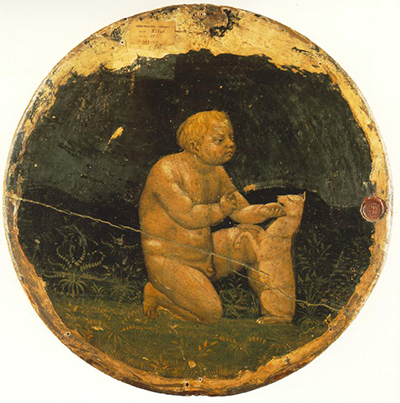Masaccio is a influential Early Renaissance artist who is well known as the forefather of art during the 15th century.
His art is world renowned and greatly showcased through an array of galleries and museums.
The genre painting was conceived between 1427-1428. The Italian painter is best known for his artwork illustrating classic scenes in nature and everyday life. Yet, he loved to portray biblical scenes and stories from the Roman Catholic religion.
His desire to recreate lifelike imagery and movement allowed for exceptionally detailed paintings that showcase impeccable detail and form. Based on this, the Masaccio had an incredible influence on artist that came about after him, and up rose the popularity of Renaissance style.
The gothic artwork of Putto and a Small Dog is an advanced perspective on realism not many artists were able to acquire during their career in the 15th century. The artist had based the focal point in the center of the artwork, drawing the viewerÕs gaze there immediately.
The small boy within the painting is known as Putto as Masaccio depicts him in his natural form bent downwards. The boy kneels on his right leg, while he bends his other leg with his left elbow placed downwards. The boyÕs left arm is placed under a Small dogs face as he grabs his face and forced his attention towards him.
The character's right arm points it's finger towards the animal as he showcases his authority upon the creature. The dog stands on its hind legs looking upon the boy as his mastery is illustrated upon him.
The artwork was conceived by the artist for the backside of the Berlin Tondo. The artist had often taken up these opportunities to create grand murals and frescos for chapels in Italy and for a few private sectors. Many of the artistÕs most famous artwork that he is known for today are based on the beautiful murals that he had painted for churches in Pisa, including Crucifixion, Madonna of Humility, and, Maria and Child.
These brilliant paintings manifested the Roman Catholic religion that the majority of the population was seized by and its impeccable portrayal of biblical stories. The painting of Putto and a Small Dog however alter from the classic biblical paintings as this portrait showcases mysterious questions behind it.
It is unknown who the character Putto within the artwork is, and the symbolism the artist attempted to obtain through illustrating him on the Berlin Tondo.
It is interesting to note that the artist had painting the artwork on a circular median in order to fit the setting. The artist had used an array of nude and orange shades to depict the body of the young boy. His form is painted with chubby features showcasing his young age. His back is awkwardly bunched as he looks upon the small dog.
The background of the painting is covered in dark shades of teal and green, gently swept near each other as no exact scene is portrayed. The perimeter of the artwork is covered in a light golden shade as the metallic colours adds a luxurious feel to the work. Masaccio had often used the rich gold colour in his murals to add to the wealth of the piece, as evident in Madonna Casini, St. Paul, and the Agony in the Garden.
Masaccio uses a small amount of the rich yellow colour and carefully paints faded vines throughout the background of the artwork upon the dark cool scenery. This detail adds a mosaic feel to the artwork, alongside intertwining different elements and colours together.




